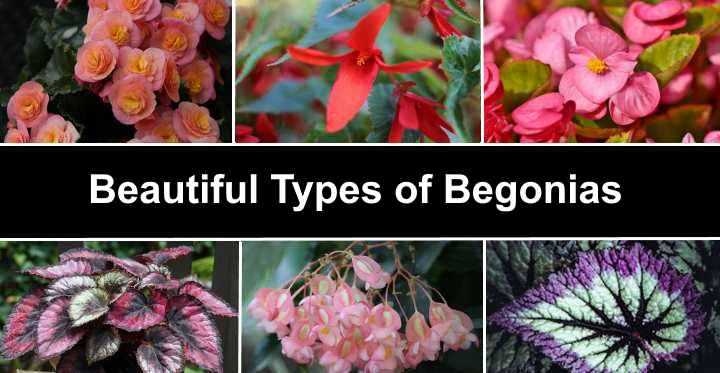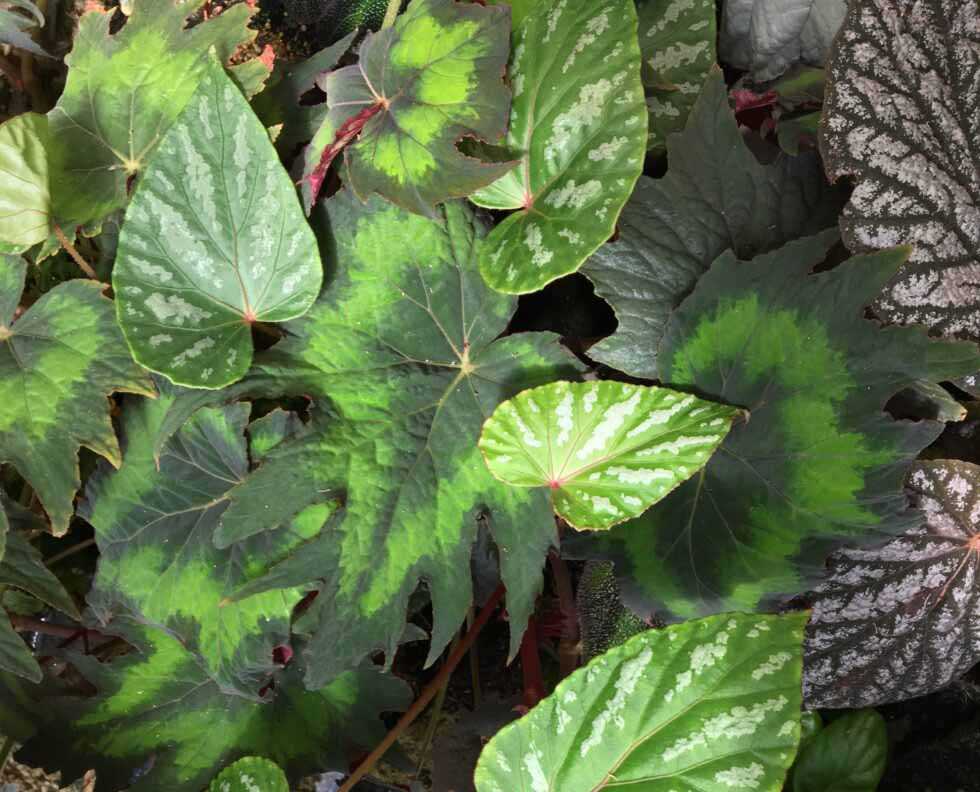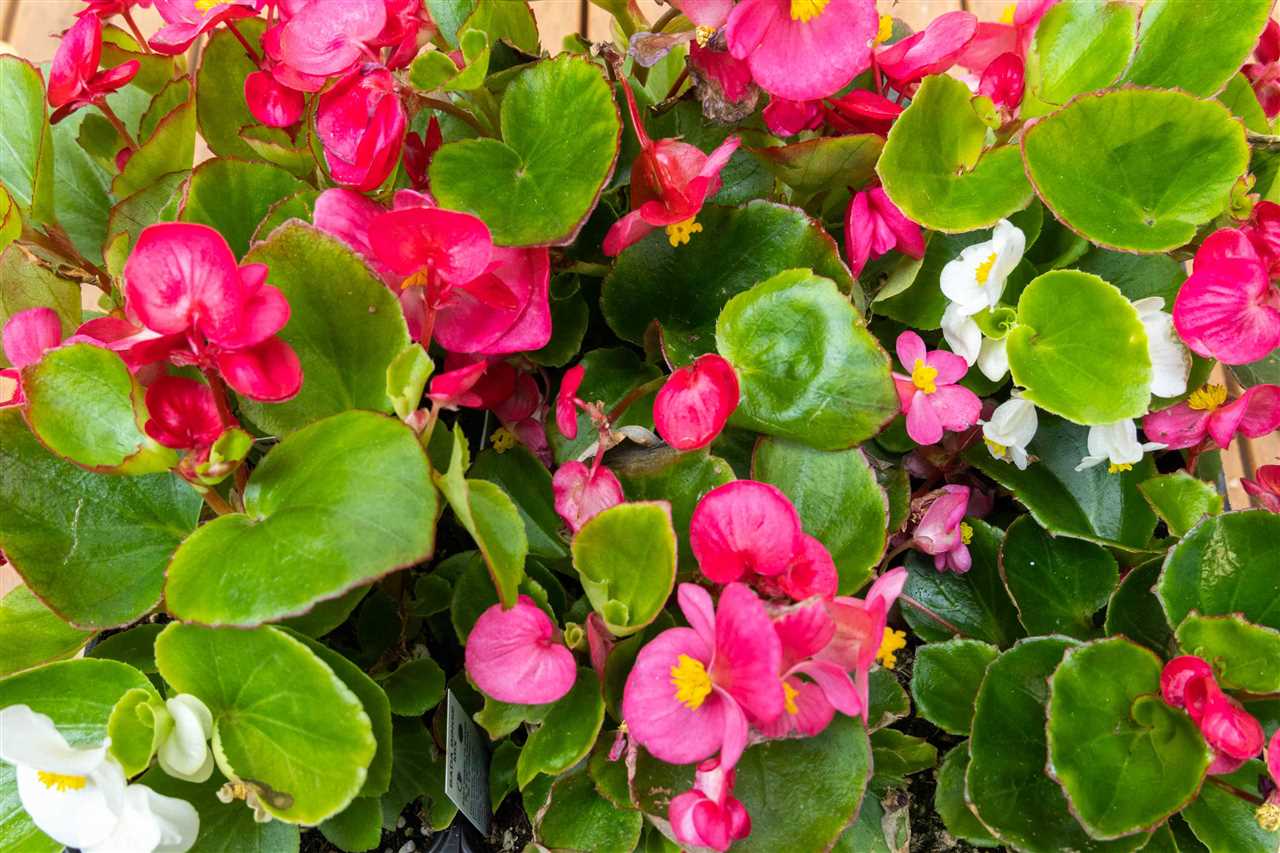Contents
Discover the Different Types of Begonias A Comprehensive Guide

Begonias are a diverse and beautiful group of plants known for their stunning leaves and vibrant flowers. With over 1,500 species, begonias offer a wide range of options for gardeners and plant enthusiasts alike. Whether you’re a beginner or an experienced gardener, there’s a begonia variety that’s perfect for you.
When it comes to caring for begonias, it’s important to understand the different types and their specific needs. Some begonias thrive in bright, indirect light, while others prefer shade. Similarly, certain varieties require more water, while others are more drought-tolerant. Understanding the specific care requirements of each type of begonia is crucial for their successful growth.
One of the most popular types of begonias is the rex begonia, known for its striking foliage. Rex begonias come in a variety of colors and patterns, with leaves that can be smooth or textured. These begonias prefer bright, indirect light and well-draining soil. They are perfect for adding a pop of color and texture to any indoor or outdoor space.
Another popular type of begonia is the tuberous begonia, which is prized for its large, showy flowers. Tuberous begonias are available in a wide range of colors, from vibrant reds and pinks to soft pastels. These begonias prefer partial shade and well-draining soil. Their flowers can be single or double, and they bloom from early summer until the first frost.
In addition to rex and tuberous begonias, there are many other types to explore, including cane begonias, rhizomatous begonias, and fibrous begonias. Each type has its own unique characteristics and care requirements, making begonias a versatile and rewarding plant to grow.
So, whether you’re looking for a begonia with stunning leaves or vibrant flowers, there’s a type of begonia that’s perfect for you. With their wide range of colors, patterns, and care requirements, begonias offer endless possibilities for adding beauty and interest to your garden or indoor space.
Tuberous Begonias

Tuberous begonias are a popular variety of begonias known for their stunning flowers. These begonias have tubers, which are swollen underground stems that store nutrients and allow the plant to survive during the dormant season. Tuberous begonias come in a wide range of colors and sizes, making them a favorite among gardeners.
The leaves of tuberous begonias are usually medium to large in size and can be either glossy or hairy. They come in various shapes, including rounded, ovate, and lobed. The foliage is often an attractive feature of these begonias, with some varieties having leaves that are deeply colored or variegated.
The flowers of tuberous begonias are the main attraction. They can be single or double, and come in a wide range of colors, including shades of pink, red, orange, yellow, and white. The flowers can be ruffled or smooth, and some varieties have petals with fringed edges. Tuberous begonias bloom from late spring to early fall, adding a splash of color to gardens and containers.
Caring for tuberous begonias involves providing them with the right growing conditions. These begonias prefer partial shade or filtered sunlight, as direct sunlight can scorch their delicate leaves and flowers. They also need well-draining soil that is kept consistently moist but not soggy. Regular fertilization is important to promote healthy growth and abundant blooms.
When growing tuberous begonias, it’s important to protect their tubers during the dormant season. After the first frost, the foliage will die back, and the tubers can be lifted from the ground and stored in a cool, dry place. They can be replanted in the spring once the danger of frost has passed.
In conclusion, tuberous begonias are a beautiful and diverse variety of begonias. With their stunning flowers and attractive foliage, they make a great addition to any garden or container. By providing them with the right care and growing conditions, you can enjoy these begonias year after year.
Characteristics of Tuberous Begonias

Tuberous begonias are a popular variety of begonias known for their showy, vibrant flowers and attractive foliage. Here are some key characteristics of tuberous begonias:
- Growing: Tuberous begonias are perennial plants that grow from tubers. These tubers should be planted in well-draining soil and kept in a location with partial shade.
- Flowers: Tuberous begonias produce large, colorful flowers in a wide range of shades, including red, pink, orange, and yellow. The flowers can be single or double, and some varieties even have ruffled petals.
- Leaves: The leaves of tuberous begonias are typically medium to dark green in color and have a glossy texture. They are often asymmetrical and have serrated edges.
- Varieties: There are many different varieties of tuberous begonias available, each with its own unique characteristics. Some popular varieties include ‘Nonstop’, ‘Pendula’, and ‘Cascading’.
- Care: Tuberous begonias require regular watering to keep the soil moist but not waterlogged. They also benefit from regular feeding with a balanced fertilizer. Deadheading spent flowers will encourage the plant to produce new blooms.
In conclusion, tuberous begonias are a beautiful addition to any garden or patio. With their stunning flowers and attractive foliage, they are sure to make a statement in any landscape. By providing the proper care and attention, you can enjoy these lovely plants for years to come.
Popular Varieties of Tuberous Begonias

Tuberous begonias are a popular type of begonia known for their vibrant flowers and interesting foliage. There are many varieties of tuberous begonias, each with its own unique characteristics and care requirements. Here are some popular varieties to consider:
- Pendula Begonias: These begonias have long, cascading stems and are perfect for hanging baskets or containers. They produce large, showy flowers in a variety of colors.
- Picotee Begonias: Picotee begonias are known for their distinctive flower edges, which are a different color than the rest of the flower. They come in a range of colors and add a touch of elegance to any garden.
- Ruffled Begonias: As the name suggests, ruffled begonias have frilly, textured petals that give them a unique and eye-catching appearance. They come in a variety of colors and are sure to make a statement in your garden.
- Non-Stop Begonias: Non-stop begonias are known for their continuous blooming throughout the summer months. They produce an abundance of flowers in various colors and are a great choice for adding color to your garden.
Growing tuberous begonias requires some care and attention. These plants prefer partial shade and well-draining soil. They should be watered regularly, but be careful not to overwater as this can cause root rot.
The leaves of tuberous begonias are also worth noting. They come in different shapes and sizes, ranging from small and rounded to large and asymmetrical. The leaves can be green, bronze, or even variegated, adding to the visual appeal of these plants.
Overall, tuberous begonias are a beautiful addition to any garden. With their wide range of colors, unique flower shapes, and interesting foliage, there is sure to be a variety that catches your eye.
Growing Tips for Tuberous Begonias

Tuberous begonias are beautiful flowering plants that are known for their vibrant colors and unique shapes. There are many varieties of tuberous begonias, each with its own characteristics and growing requirements. Here are some tips to help you grow tuberous begonias successfully:
- Choose the right variety: There are different types of tuberous begonias, including single-flowered, double-flowered, and trailing varieties. Choose the variety that suits your preferences and growing conditions.
- Provide the right growing conditions: Tuberous begonias prefer partial shade or filtered sunlight. They thrive in well-draining soil that is rich in organic matter. Avoid overwatering, as it can lead to root rot.
- Plant the tubers correctly: Tuberous begonias should be planted with the concave side facing up. Plant them shallowly, with the top of the tuber just slightly covered with soil.
- Water regularly: Tuberous begonias need regular watering to keep their soil moist but not waterlogged. Water them deeply when the top inch of soil feels dry.
- Fertilize regularly: Feed your tuberous begonias with a balanced fertilizer every two weeks during the growing season. This will help promote healthy growth and abundant flowering.
- Pinch back the stems: To encourage bushier growth and more flowers, pinch back the stems of your tuberous begonias when they reach about 6 inches in height. This will also help prevent leggy growth.
- Deadhead spent flowers: Remove faded or spent flowers to encourage continuous blooming. This will also help redirect the plant’s energy towards producing new blooms.
- Protect from pests: Tuberous begonias can be susceptible to aphids, spider mites, and other common garden pests. Keep an eye out for any signs of infestation and take appropriate measures to control them.
By following these growing tips, you can enjoy the beauty of tuberous begonias in your garden or containers. With their stunning flowers and lush foliage, they are sure to add a touch of elegance to any space.
Rhizomatous Begonias

Rhizomatous begonias are a popular type of begonia plants that are known for their unique rhizomes, which are thick, horizontal stems that grow underground. These plants have a wide variety of leaf shapes, sizes, and colors, making them a favorite among begonia enthusiasts.
The leaves of rhizomatous begonias can range from small and round to large and asymmetrical. Some varieties have leaves with intricate patterns and textures, while others have smooth, glossy surfaces. The colors of the leaves can vary from deep green to shades of silver, red, and purple.
Caring for rhizomatous begonias is relatively easy. These plants prefer bright, indirect light and well-draining soil. They should be watered regularly, allowing the soil to dry out slightly between waterings. Overwatering can lead to root rot, so it’s important to avoid keeping the soil too wet.
One of the unique features of rhizomatous begonias is their ability to produce new plants from their rhizomes. These new plants, called offsets, can be separated from the parent plant and potted individually to grow into new plants. This makes rhizomatous begonias a great option for propagating and expanding your begonia collection.
Rhizomatous begonias also produce beautiful flowers, although they are not as showy as some other types of begonias. The flowers can be small and inconspicuous or larger and more noticeable, depending on the variety. The colors of the flowers can range from white and pink to orange and red.
Overall, rhizomatous begonias are a diverse and fascinating group of plants. Their unique rhizomes, wide variety of leaf types, and easy care requirements make them a great choice for both beginner and experienced gardeners. Whether you’re looking to add some color to your indoor space or enhance your outdoor garden, rhizomatous begonias are sure to delight with their beauty and charm.
Characteristics of Rhizomatous Begonias

Rhizomatous begonias are a type of begonia plant that is known for their unique characteristics and beautiful foliage. These plants are easy to care for and come in a variety of different varieties, making them a popular choice for both indoor and outdoor gardens.
One of the most distinctive features of rhizomatous begonias is their rhizomes, which are thick, fleshy stems that grow horizontally underground. These rhizomes store water and nutrients for the plant, allowing it to survive in various conditions.
Rhizomatous begonias also have unique leaves that come in a variety of shapes, sizes, and colors. Some varieties have large, round leaves, while others have small, asymmetrical leaves. The leaves can be smooth or textured, and they may have patterns or variegations on them.
Another characteristic of rhizomatous begonias is their ability to produce flowers. While the flowers of rhizomatous begonias are not as showy as other types of begonias, they are still beautiful and can add a pop of color to any garden. The flowers come in a variety of colors, including pink, red, orange, and white.
Growing rhizomatous begonias is relatively easy, as they are adaptable and can thrive in a range of conditions. They prefer bright, indirect light and well-draining soil. These plants should be watered when the top inch of soil is dry, but they should not be overwatered, as this can lead to root rot.
To care for rhizomatous begonias, it is important to regularly check the leaves for any signs of pests or diseases. If any issues are found, they should be treated promptly to prevent further damage to the plant.
In conclusion, rhizomatous begonias are a unique and beautiful type of begonia plant. With their distinctive rhizomes, varied leaf shapes and colors, and ability to produce flowers, they are a popular choice for both beginner and experienced gardeners. With proper care and attention, these plants can thrive and add beauty to any garden.
Popular Varieties of Rhizomatous Begonias

Rhizomatous begonias are a popular type of begonia known for their unique leaves and beautiful flowers. These plants are easy to care for and come in a variety of types and varieties. Here are some popular varieties of rhizomatous begonias:
- Rex Begonia: This variety of rhizomatous begonia is known for its stunning foliage. The leaves are often large and colorful, with patterns and textures that resemble reptile skin. Rex begonias are popular houseplants and can be grown indoors or outdoors in a shady spot.
- Iron Cross Begonia: The iron cross begonia is named for the distinctive pattern on its leaves, which resembles an iron cross. This variety is known for its hardiness and ability to tolerate a wide range of growing conditions. It is a great choice for beginners or those looking for a low-maintenance plant.
- Dragon Wing Begonia: Dragon wing begonias are a popular variety known for their cascading habit and abundant flowers. These begonias produce clusters of bright red or pink flowers that bloom continuously throughout the growing season. They are great for hanging baskets or as ground cover in shaded areas.
- Boliviensis Begonia: Boliviensis begonias are a trailing variety that is perfect for hanging baskets or containers. They have tubular flowers that come in a range of colors, including red, orange, and yellow. These begonias are heat-tolerant and can withstand full sun, making them a great choice for summer gardens.
- Angel Wing Begonia: Angel wing begonias are known for their unique wing-shaped leaves, which have silver spots or streaks. They produce clusters of delicate flowers in shades of pink, red, or white. These begonias are popular houseplants and can also be grown outdoors in a shady spot.
These are just a few examples of the many types and varieties of rhizomatous begonias available. Whether you prefer bold foliage or colorful flowers, there is sure to be a rhizomatous begonia that suits your taste and style. With their easy care and beautiful appearance, it’s no wonder why rhizomatous begonias are a favorite among gardeners and plant enthusiasts.
Growing Tips for Rhizomatous Begonias

Rhizomatous begonias are a popular type of begonia that are known for their beautiful flowers and unique leaves. These plants are easy to care for and can be a great addition to any garden or indoor space. Here are some tips for growing rhizomatous begonias:
- Light: Rhizomatous begonias prefer bright, indirect light. They can tolerate some shade, but too much direct sunlight can scorch their leaves.
- Watering: It’s important to keep the soil evenly moist for rhizomatous begonias. Water them when the top inch of soil feels dry, and be sure not to overwater as this can lead to root rot.
- Humidity: These begonias thrive in high humidity environments. You can increase humidity by placing a tray of water near the plants or by misting them with water regularly.
- Temperature: Rhizomatous begonias prefer temperatures between 60-75°F (15-24°C). They can tolerate slightly cooler temperatures, but they are sensitive to frost.
- Fertilizer: Feed rhizomatous begonias with a balanced, water-soluble fertilizer every 4-6 weeks during the growing season. Be sure to follow the instructions on the fertilizer package for proper dosage.
- Pruning: Remove any dead or yellowing leaves to keep your begonias looking their best. You can also prune them back to shape if they become leggy or overgrown.
Rhizomatous begonias come in a variety of colors and patterns, making them a versatile choice for any garden or indoor space. With proper care and attention, these plants can thrive and bring beauty to your home.
Video:Discover the Different Types of Begonias A Comprehensive Guide
Hello, I am Beverly J. Sanders, the voice behind the diverse articles you come across on styves.co.za. My passion lies in exploring the nuances of home improvement and sharing tips that can help you transform your living space into a haven of comfort and style. From the latest trends in home decor to practical cleaning advice, I cover a broad spectrum of topics to cater to a wide variety of interests.
In my recent works, I have delved into the advantages of incorporating a horizontal Murphy bed into your home to save space without compromising on design and functionality. I also explored the benefits of having a free-standing electric fireplace that not only adds warmth to your home but also brings a sleek and modern design to any living space. My articles are a rich resource, offering insights into different products and home improvement strategies that can enhance the quality of your life.
I believe in the power of details; a belief that reflects in my comprehensive guides where I discuss even the overlooked aspects of home decor, such as the impact of baseboard trim in enhancing the overall look and feel of your home. I am constantly on the lookout for innovative solutions and products that can add value to your home and life.
Join me in my exploration as I continue to bring you the latest trends, tips, and insights in the home improvement world. Let’s create a home that is not just a place to live, but a reflection of style and personality.